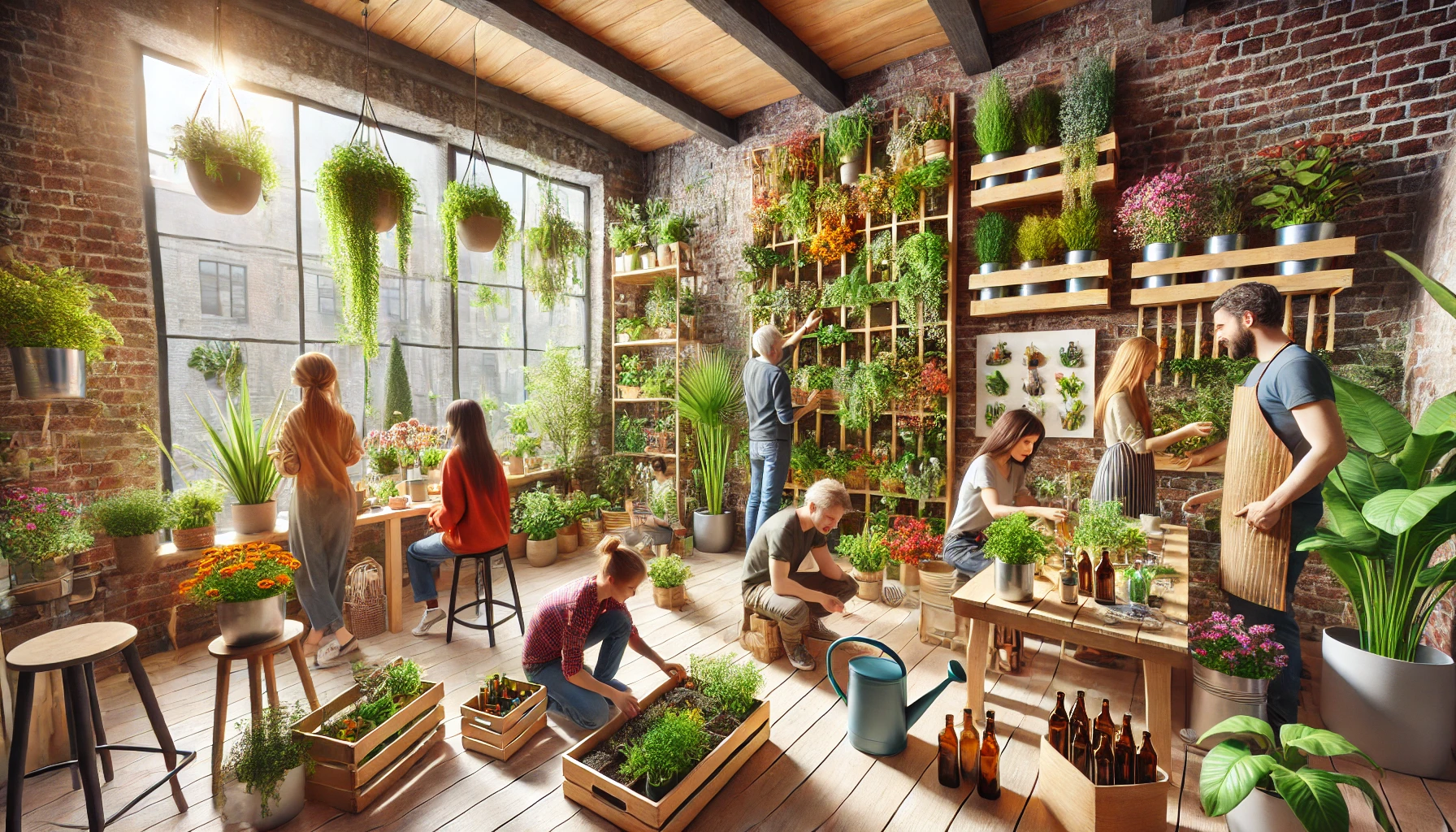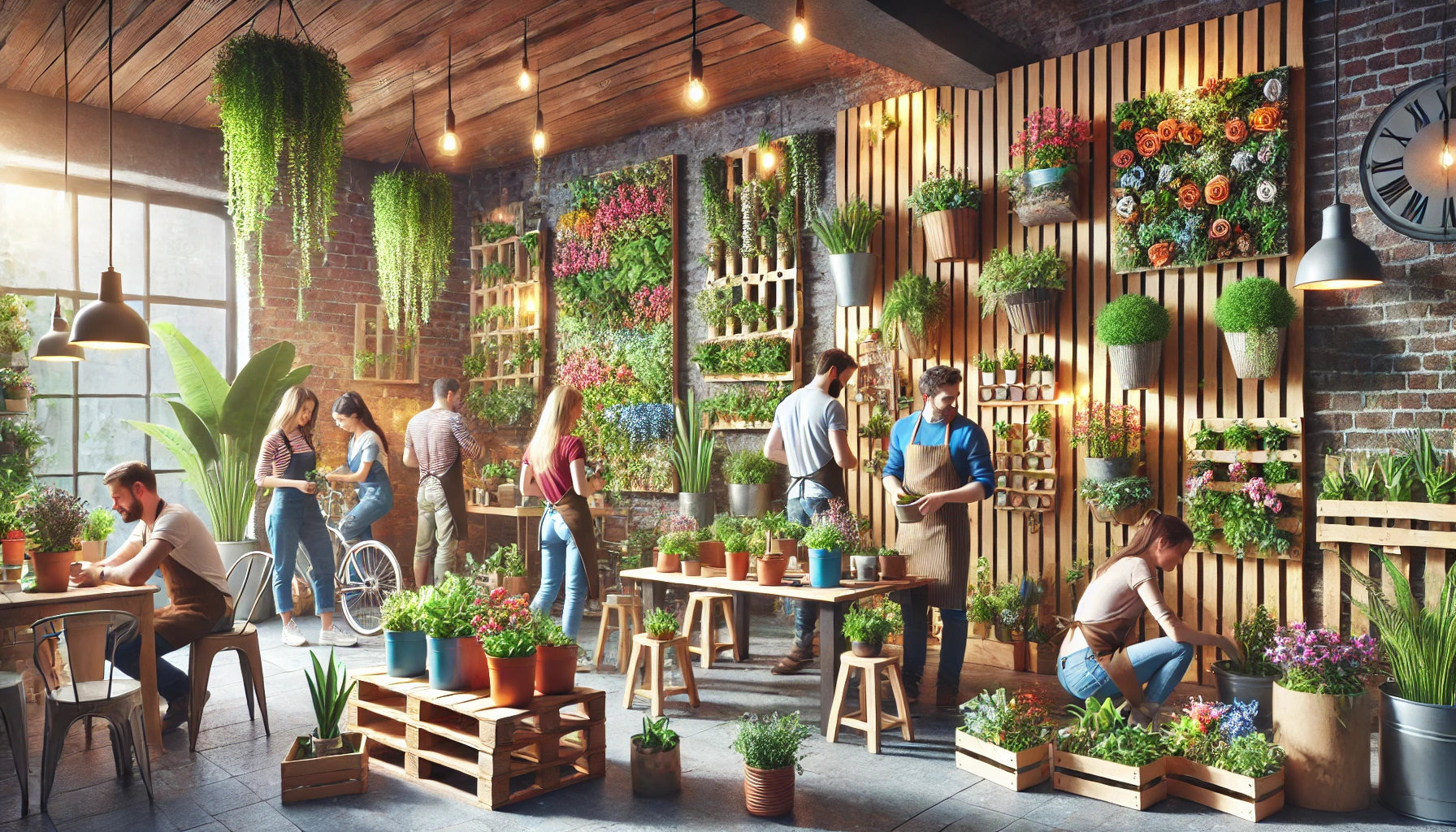Introduction to DIY Vertical Gardening
DIY vertical gardening ideas are revolutionizing how urban dwellers bring nature into their homes, offering creative solutions for gardening in limited spaces.
With urbanization on the rise, more people are finding joy in growing their plants, even within the confines of small apartments or balconies.
Vertical gardening has gained immense popularity due to its ability to transform blank walls, fences, or compact areas into lush, green spaces.
One of the key benefits of vertical gardens is their ability to maximize space, allowing you to grow herbs, vegetables, or ornamental plants without requiring a traditional garden plot.
Beyond space-saving, vertical gardens also enhance air quality, create a soothing ambiance, and provide a sense of accomplishment for DIY enthusiasts.
Let’s dive into innovative and simple ideas that anyone, regardless of skill level, can try at home.
Innovative Yet Simple DIY Vertical Gardening Ideas
Vertical gardening doesn’t have to be complicated. One creative idea involves using hanging planters made with terracotta pots and sturdy rope.
By drilling holes in the pots, threading the rope, and securing it with knots, you can create an attractive arrangement of planters hung at varying heights.
Lightweight soil can be used to reduce strain, ensuring a functional yet visually appealing setup.
Repurposing wooden pallets is another simple project that caters to various skill levels. By attaching landscape fabric to the back and sides of a pallet, you can create pockets to hold soil and plants.
Leaning the pallet against a wall transforms it into an instant vertical garden. This method works well for herbs or small flowers, making it a versatile and eco-friendly option.
Empty tin cans can also be transformed into an eye-catching vertical herb garden. Cleaned and painted cans can be nailed to a wooden board in a grid pattern, providing a rustic yet functional look.
By filling the cans with soil and planting your favorite herbs, you create a practical and sustainable gardening solution.
Another innovative idea involves creating a vertical gutter garden using old rain gutters. These can be cut into sections, attached horizontally to a wall, and filled with soil to grow small vegetables like radishes or lettuces.
For aesthetic appeal, you can paint the gutters and arrange them in multiple tiers to increase planting capacity.
Effortless and Easy Ideas for Vertical Gardening Enthusiasts
For those who prefer quick and simple setups, recycled plastic bottles offer a fantastic solution. By cutting the bottles in half, punching drainage holes, and attaching strings, you can create a hanging garden perfect for herbs or small flowers. This low-maintenance option requires only light watering, making it ideal for busy individuals.
Wooden crates mounted on an outdoor wall are another effortless idea. These crates can be filled with soil and arranged with plants of varying heights and colors to create a dynamic and visually appealing garden. Rotating the plants regularly ensures even sunlight distribution, promoting healthy growth.
Picture frame succulent gardens are a unique and artistic option for vertical gardening. By attaching chicken wire to a deep picture frame, filling it with moss, and poking succulent cuttings through the wire, you can create a living work of art. These frames can be mounted on walls, adding greenery to any space while requiring minimal maintenance.
Vertical Garden Ideas Tailored for Small Spaces
Gardening in small spaces requires ingenuity and resourcefulness. Wall-mounted planters are a practical solution, as they allow for the cultivation of herbs, flowers, or succulents in a compact design that doesn’t protrude far from the wall.
Hanging pots, placed on curtain rods or ceiling hooks, are another excellent choice for small balconies. Cascading plants like pothos or ferns thrive in these setups, creating a lush, vibrant look.
A vertical ladder garden offers a charming and functional option for compact areas. By attaching small pots to each step of an old ladder and placing it in a sunny spot, you can maximize your gardening potential without taking up valuable floor space.
Similarly, a shoe organizer herb garden involves hanging a canvas organizer on a wall or fence, filling its pockets with soil, and planting herbs like basil, mint, or thyme.
Stackable planters are another efficient way to utilize vertical space. These planters allow for multiple layers of plants in a small footprint. Rotating the tiers periodically ensures even exposure to sunlight, promoting optimal growth.
Exploring Diverse Vertical Gardening Systems
Commercially available vertical gardening systems provide advanced options for enthusiasts looking for convenience and efficiency. Modular wall planters, featuring interlocking panels that hold multiple plants, are customizable and easy to install. While they can be expensive, their versatility makes them a popular choice.
Pocket systems, made of fabric or felt, allow plants to grow in individual compartments. These lightweight systems are space-efficient but require frequent watering to maintain plant health.
Hydroponic setups, which use nutrient-rich water instead of soil, are another innovative option. Although these systems involve higher upfront costs and maintenance, they are ideal for growing vegetables and offer impressive efficiency.
Tower gardens represent the pinnacle of modern vertical gardening systems. These vertical towers circulate water and nutrients to multiple plants within one unit, saving water and maximizing productivity. While the initial investment can be substantial, the long-term benefits often outweigh the costs.
Cost-effective and Cheap DIY Vertical Garden Solutions
Creating a vertical garden on a budget is entirely possible with a bit of creativity. Upcycled materials such as old shoe organizers or mason jars can be repurposed into functional and decorative planters. For example, mason jars mounted on a wooden frame provide a rustic yet practical solution for growing herbs.
PVC pipes offer another budget-friendly option. By cutting the pipes into sections, drilling holes for planting, and arranging them vertically or horizontally on a wall, you can create a striking garden. This method works particularly well for growing strawberries or small flowers.
Thrift stores are excellent resources for finding items like old picture frames, crates, or shelves that can be transformed into planters. With a fresh coat of paint, these items can become attractive additions to your vertical garden while keeping costs low.
Cultivating DIY Vertical Gardening Ideas for Small Spaces
Urban areas often present challenges for gardening due to limited space, but vertical gardens offer effective solutions.
Layered setups, such as tiered shelves or hanging racks, allow for the cultivation of multiple plants in a compact area. This approach maximizes vertical space while maintaining an organized and appealing aesthetic.
Selecting the right plants is crucial for small spaces. For sunny areas, herbs like basil, mint, and cherry tomatoes are excellent choices. For shaded spots, ferns and ivy thrive, providing greenery even in less-than-ideal conditions.
Hanging baskets, arranged at varying heights, add visual interest and accommodate trailing plants like petunias or lobelia for a cascading effect.
Compact vertical herb gardens are another innovative solution. Narrow planters that fit snugly into corners or tight spaces can accommodate a mix of herbs, offering both culinary and decorative benefits. By utilizing every inch of available space, these gardens demonstrate the adaptability of vertical gardening.

Building DIY Vertical Gardening Projects on a Budget
Cost-cutting measures can make vertical gardening accessible to everyone. Using thrift materials like old ladders, crates, or pots keeps expenses low while providing a unique, personalized touch. Affordable planters can be created from everyday items such as tin cans, plastic containers, or even old gutters.
Adding aesthetic enhancements doesn’t have to be costly. Fairy lights or colorful paints can transform a simple vertical garden into a visually stunning feature. By focusing on creativity and resourcefulness, you can achieve remarkable results without overspending.
The Rewarding World of DIY Vertical Vegetable Gardens
Vertical vegetable gardens offer the dual benefits of space-saving and sustainable food production. Best practices include using trellises or cages for climbing vegetables like tomatoes and beans and ensuring proper drainage to prevent root rot.
Seasonal planting is key to success; for instance, leafy greens like lettuce thrive in cooler months, while peppers and cucumbers flourish during warmer seasons.
Continuous harvest is achievable through crop rotation, which maintains soil health and maximizes yields. Vertical hydroponic vegetable gardens take this concept further by enabling year-round cultivation of lettuce, spinach, or herbs.
Monitoring water and nutrient levels ensures optimal growth, making hydroponics an efficient and sustainable choice.
Creating a vertical vegetable garden combines practicality with sustainability, providing fresh, organic produce while enhancing the aesthetic appeal of your space.
Conclusion
DIY vertical gardening ideas are a fantastic way to bring greenery into your home, no matter the size of your space or your budget. From repurposed household items to advanced hydroponic systems, there are endless ways to create a thriving vertical garden.
Whether you’re looking to grow vegetables, herbs, or decorative plants, the possibilities are only limited by your imagination. Embrace the joy of vertical gardening and transform your small spaces into lush, vibrant sanctuaries.


Vertical gardening is such a game-changer for small spaces! I’ve been eyeing the idea of using old pallets or even mason jars for a DIY setup, but I’m curious—what’s worked best for you? Anyone tried something totally outside the box, like upcycled furniture or quirky thrift store finds? I’d also love to hear if hydroponic setups are worth the investment or if simpler ideas hold up better long-term. Let’s swap stories!
“Totally agree—vertical gardening is a lifesaver for small spaces! I’ve had great success with modular wall planters—they’re easy to set up and super customizable. Upcycled furniture is such a creative idea! I once turned an old bookshelf into a vertical herb garden, and it worked like a charm. As for hydroponics, I recently started experimenting with a small setup, and while the upfront cost is higher, the results have been amazing—faster growth and less mess compared to soil. If you’re just starting out, though, mason jars or pallets are solid options. What kind of plants are you thinking of growing? Let’s share tips!”